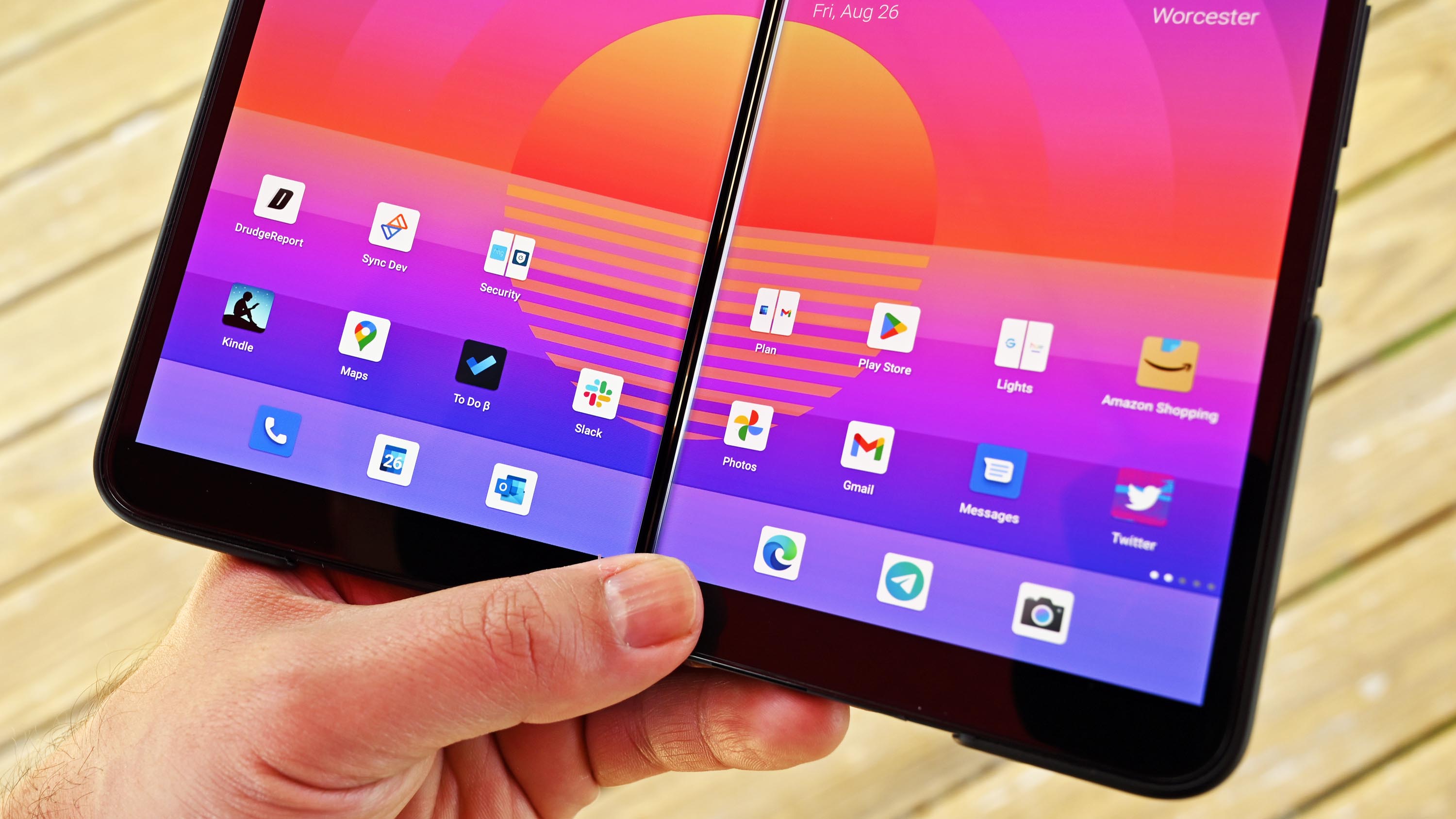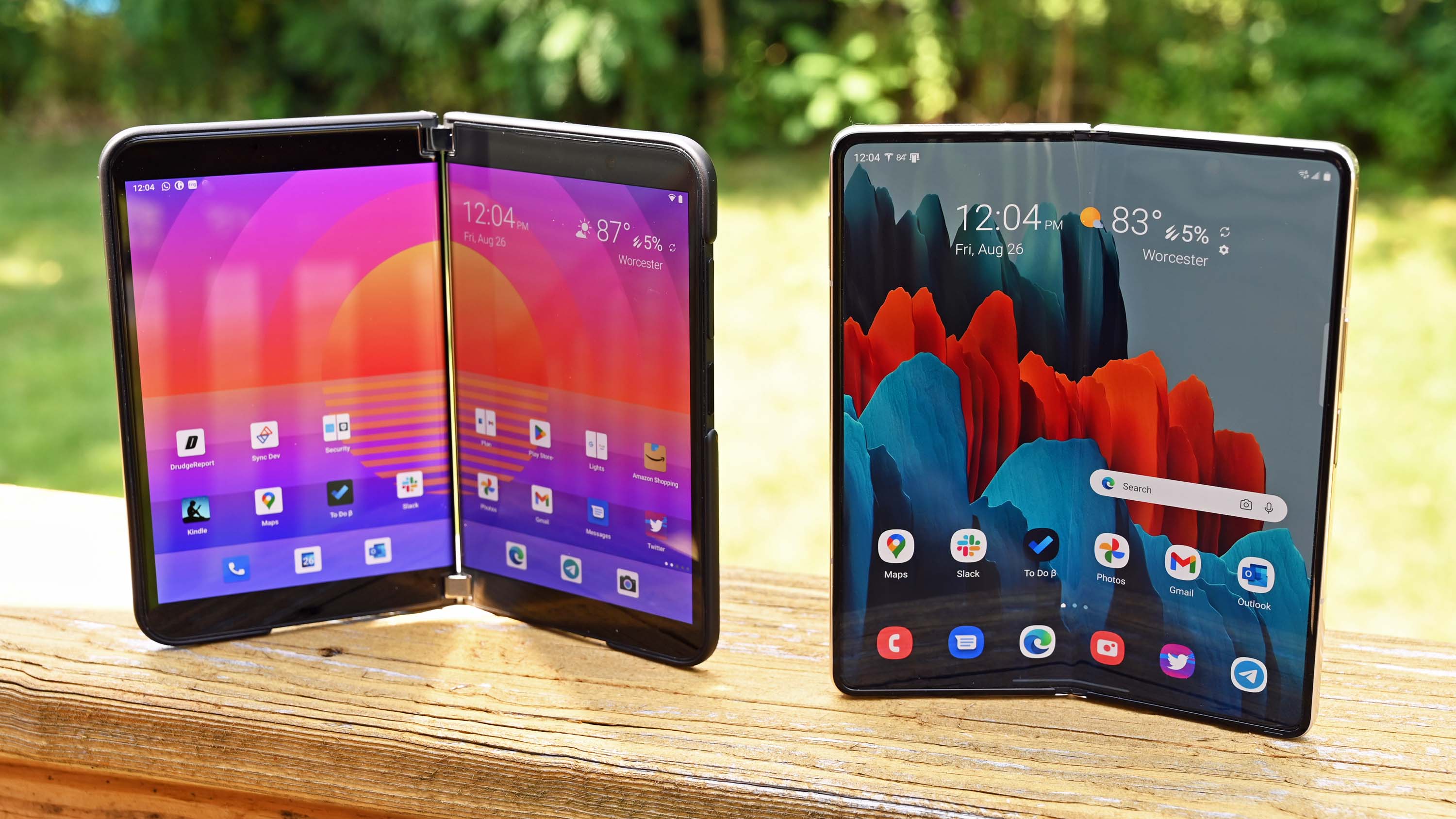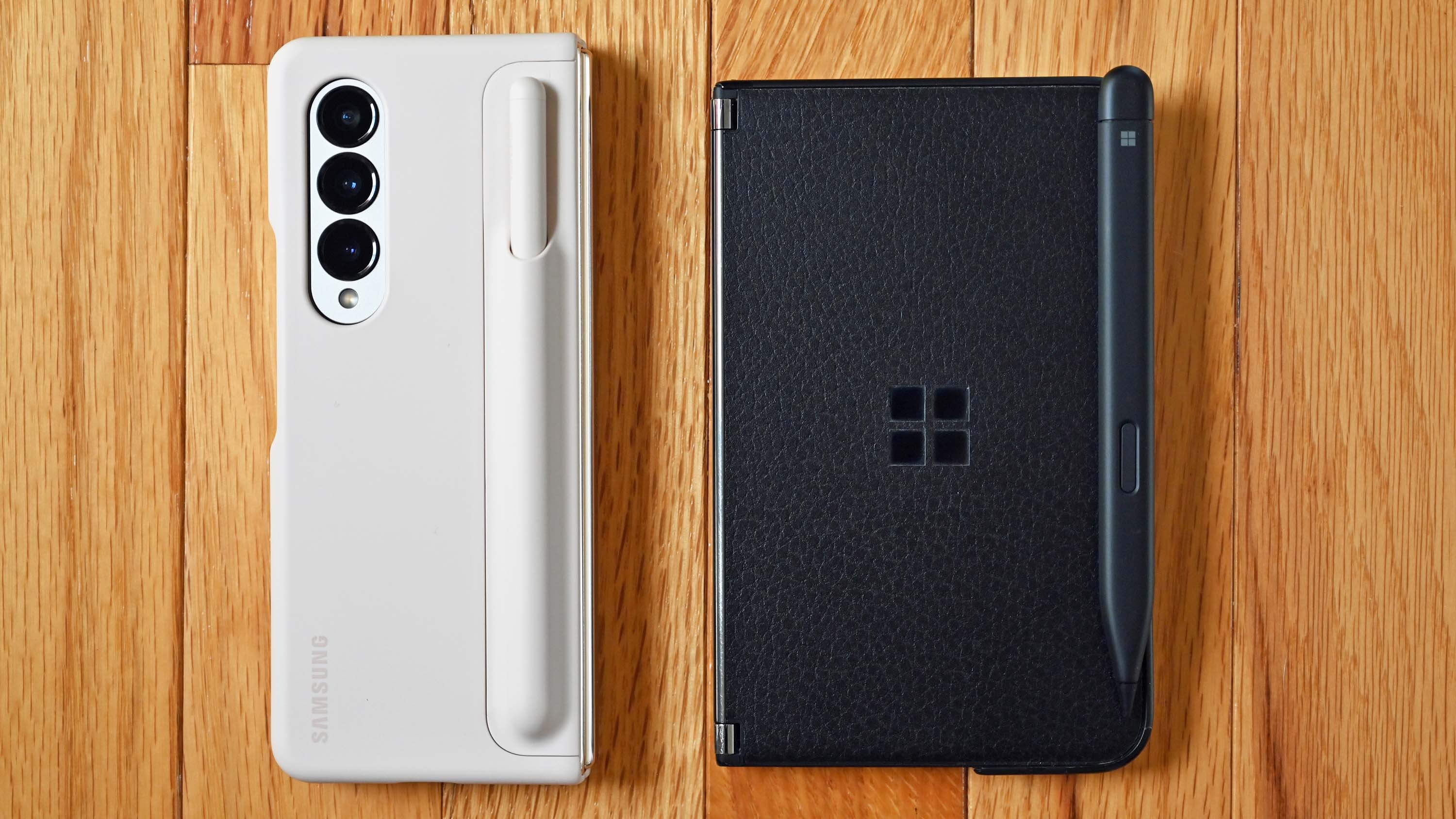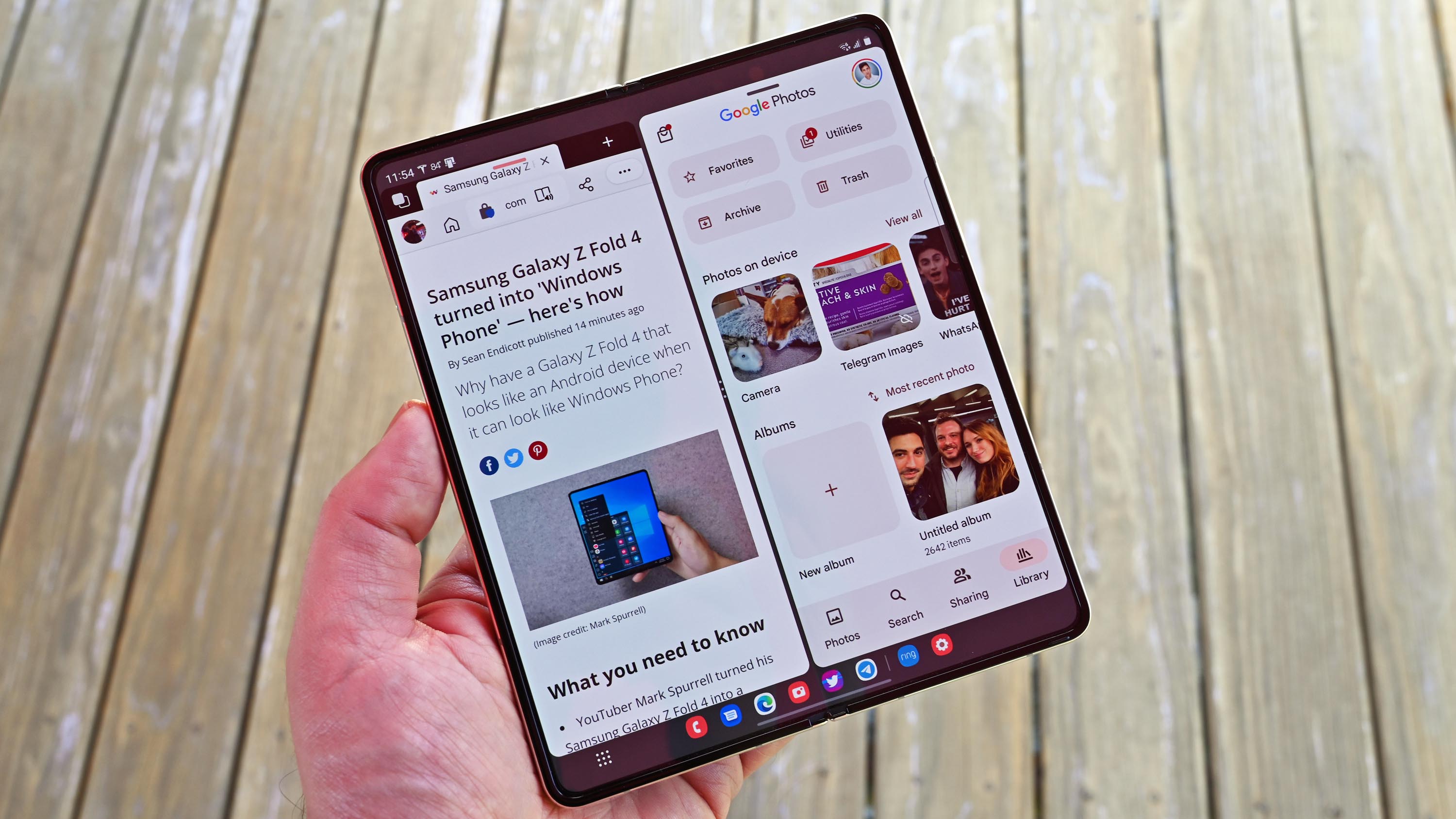I'm a little less excited for the Surface Duo 3 now
While the move to a foldable display makes sense, it's also less interesting.

I want to preface this article with a simple statement: When it came time to replace my wonderful Samsung Galaxy Note 20 Ultra, I ultimately chose the Galaxy Z Fold4 over the Surface Duo 2. Superior cameras, water resistance, wireless charging, and an uncompromised software experience were all reasons I used to justify my purchase (that and the unbeatable trade-in deal Samsung gave me on my old phone).
That's not to say I don't find the Surface Duo 2 to be an incredibly interesting device. I own an original Surface Duo, and the form factor and design are endlessly fascinating. I love picking it up and using it with no real purpose in mind because the hinges and the dual screens are just that enticing. The Duo 2 didn't meet all my requirements for a daily driver, but I had high hopes that Microsoft's Surface Duo 3 may address my concerns and finally realize the dreams of this form factor.
Unfortunately, the recent report that the Surface Duo 2 successor will move to a singular, foldable internal display has dashed my excitement.
Becoming a follower, not a leader

Foldable smartphones are continuing to evolve rapidly, as companies pour resources into researching how best to capitalize on the emerging market and become a leader for the next wave of smartphones. Samsung, being one of the earliest players in the space, is a dominating force that now sells the Fold4 and Flip3 — premium foldable devices that can actually be comfortably recommended to almost anyone.
Samsung is the leader in foldables, and other companies are either following its example or trying to find ways to differentiate their devices to attract consumers' attention. One company that deliberately chose to forge its own path, however, was Microsoft. The company's insistence on a custom, entirely unique dual-screen format for the original Surface Duo understandably generated controversy at launch by placing productivity and multitasking above all else.
Microsoft deliberately chose to forge its own path with the Surface Duo 2.
By eschewing a singular, fragile foldable display for two traditional smartphone screens divided by Microsoft's industry-leading hinges, Microsoft was offering something that no one else was at the time. The idea of a portable, entertainment-suited tablet was traded for the ultimate machine for multitasking on the go. Unfortunately, hardware compromises and frankly terrible software led the original Surface Duo to be struck with masses of negative reviews and constant comparisons to foldable smartphones — even when inappropriate — which all contributed to an immediately tarnished reputation for Microsoft's nascent Duo line.

The Surface Duo 2 addressed almost all of the hardware concerns with its predecessor, and Microsoft has since improved the software to the point where it's reliable and packed with enough features to satisfy the majority of users. The damage had already been done, though, and Microsoft continued to struggle to sell the dual-screen form factor to users. I understood the appeal, though, as did Windows Central's Daniel Rubino, who made the opposite choice I did by choosing the Surface Duo 2 over the Galaxy Z Fold4.
All the latest news, reviews, and guides for Windows and Xbox diehards.
Unfortunately, Microsoft has reportedly chosen to pivot away from the design laid out by the first two Surface Duo generations, abandoning the work it has done on the form factor to instead chase after the established market leader in foldables. The next Surface Duo, which may or may not possess that name, will mirror Samsung and other companies with a singular internal foldable display and a separate external display. While the decision to make the Surface Duo 3 a foldable makes a lot of sense for Microsoft, it's not what I wanted to see.
An uphill battle, just to compete

The Surface Duo line in its current iteration has an issue with image, not execution. The Surface Duo 2 is a generally fantastic device with functional software and a focused purpose not seen in any other personal smartphone. Until you sit down with a Surface Duo and use it for a significant amount of time, it may be difficult to wrap your mind around how seamless multitasking is when you have two displays.
Comparisons to foldable smartphones were inevitable, however, and the masses that have yet to use a Surface Duo — or at whom the device simply isn't targeted — may struggle to come up with a reason why the device exists versus cutting-edge foldable smartphones like the Z Fold4, especially given the similar price points. It's unclear if Microsoft could ever overcome this intrinsic doubt surrounding the Duo brand, even if the Duo 3 had continued the major evolutions we saw going from the original Duo to its sequel. For that reason, I fully understand Microsoft's decision to merge Duo's displays into one foldable screen.

Now, however, Microsoft is confronted with an all-new challenge — competing with the already entrenched market leader, Samsung, who has spent years working on and polishing its foldable smartphones to be above and beyond anything else that's widely available to users. Microsoft, which is new to the world of Android devices, must now figure out how to fight an uphill battle and justify the existence of a Surface-branded foldable smartphone that may not do anything unique compared to Samsung's own devices.
Microsoft now has to compete with the already entrenched market leader for foldables.
To have a chance to compete, Microsoft needs the Duo 3 to go toe-to-toe with Samsung in every hardware category while also ensuring that the software experience is polished and feature-packed from day one. There's little to no reason to have confidence in Microsoft's ability to do this, as the company's first-gen devices tend to be heavily compromised. Beyond that, though, the Duo 3 needs to have a reason to exist — if the line no longer centers around dual screens that naturally encourage and guide seamless multitasking, how will the Duo 3 be a convincing competitor to Samsung?
The Samsung Galaxy Z Fold4 already works great with Microsoft's other services, with built-in integrations to Phone Link, OneDrive, and more. Microsoft may be able to differentiate its foldable Duo with additional software features, but would that be enough to convince potential buyers to bet on the newcomer rather than the tried-and-true champion? I'm not confident, but my doubt goes a little deeper than that.
At the end of the day, I'm just not excited

I have been eagerly waiting to see what Microsoft delivers with the Surface Duo 3. The Duo 2 was so close to convincing me to pull the trigger. Only the omission of wireless charging was a major deterrent, which Microsoft reportedly intended to fix with the Duo 3. To hear that Microsoft has thrown all of that potential away to join a growing number of manufacturers in the foldable space is... disappointing.
I chose the Samsung Galaxy Z Fold4 as my daily driver because Samsung's foldable offered the features and experience I need from my smartphone, which the Duo 2 didn't quite deliver. However, it had nothing to do with the overall form factor. I would've been equally content with a foldable or a dual-screen device, understanding that they ultimately offer very different experiences; the details swayed me either way, and Microsoft had every opportunity to address my concerns with the Surface Duo 3.
Instead, the company is stepping up to Samsung (not to mention Google's rumored Pixel foldable) and its decades of experience and billions of dollars of R&D to make another foldable smartphone that may not meaningfully advance the market or differentiate itself from competitors. Microsoft still may surprise me, and the Surface Duo 3 could still prove itself to be worthy of sitting next to the Galaxy Fold4 (or, by the time it comes out, Galaxy Fold5) — despite my reservations to believe. Even if that happens, though, I'll be left wondering what could have been if Microsoft had committed a little bit longer to a true Duo smartphone.
At least I still have the Lenovo YogaBook 9i dual-screen laptop to drool over. If Lenovo is feeling generous, I'd like mine in blue.

Zachary Boddy (They / Them) is a Staff Writer for Windows Central, primarily focused on covering the latest news in tech and gaming, the best Xbox and PC games, and the most interesting Windows and Xbox hardware. They have been gaming and writing for most of their life starting with the original Xbox, and started out as a freelancer for Windows Central and its sister sites in 2019. Now a full-fledged Staff Writer, Zachary has expanded from only writing about all things Minecraft to covering practically everything on which Windows Central is an expert, especially when it comes to Microsoft.
